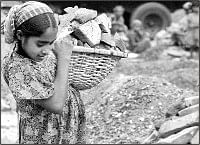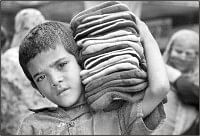Human Rights advocacy
Child labour in Bangladesh
Poverty alleviation must for overcoming the problem
Nurul Haque
 Child labour in Bangladesh although not new but has increased alarmingly in recent years. It started in agricultural sector then and has spread over 430 sectors now. Among the lot of obstacles we have child labour appears to be the most imposing in the way to reach the millennium development goal. For this reason a number of organizations are working for reducing child labour in the country. Child labour in Bangladesh came in the limelight in mid-1990s when a US senator lobbied for a bill to restrict the import of Bangladeshi garment products that used child labour.
Child labour in Bangladesh although not new but has increased alarmingly in recent years. It started in agricultural sector then and has spread over 430 sectors now. Among the lot of obstacles we have child labour appears to be the most imposing in the way to reach the millennium development goal. For this reason a number of organizations are working for reducing child labour in the country. Child labour in Bangladesh came in the limelight in mid-1990s when a US senator lobbied for a bill to restrict the import of Bangladeshi garment products that used child labour.
Child labour is of course the most severe form of child exploitation and child abuse in the world. In any society, working children, as a socio-economic group, happens to be the most disadvantaged of all since they are forced to work for a living, sacrificing their childhood as well as their future for bare survival of self and family. The United Nations and the International Labour Organization has always been working against child labour. In article 32 of the Convention on the Rights of the Child it is stated that:...State Parties recognize the right of the child to be protected from economic exploitation and from performing any work that is likely to be hazardous or to interfere with the child's education, or to be harmful to the child's health or physical, mental, spiritual, moral or social development.
Concept of child labour
There is no universally accepted definition of child labour. Various definitions of the term are used by international organizations, non-governmental organizations (NGO), trade unions and other interest groups. Writers and speakers don't always specify what definition they are using, and that often leads to confusion, nonetheless we are trying to conclude the meaning of child labour:
When children undertake jobs which are risky in regards to their age, exploitative in nature and in conflict with the existing laws, it is identified as child labour. The formal as well as informal child labour which is physically, mentally and morally harmful to children and do not commensurate with their needs and rights can be called child labour. However, any productive work which is conducive to the physical, mental and moral development the child can be considered as child's work.
 Different forms of child labour in Bangladesh
Different forms of child labour in Bangladesh
Firstly we can divide the total child labour in Bangladesh in three segments, namely Child labour in general, Hazardous child labour and Worst forms of child labour. According to Bangladesh Shishu Adhikar Forum, our child workers are involved in 430 types of economic activities. Child labour can be factory work as in tannery, metal workshop, garments or in big factories; mining or quarrying; agriculture; helping in the parents' business, having one's own small business (for example selling food), or doing odd jobs. Some children work as guides for tourists, sometimes they are work for bringing in business for shops and restaurants (where they may also work as waiters). Other children are forced to do tedious and repetitive jobs such as assembling boxes or polishing shoes.
In an agricultural country like ours, most of the families depend on farming. Most of the children who live in rural or suburban areas are involved in agricultural sector and guardians treat it as family responsibility. As a result urban children do better in every sector than rural children. This sector had not been highlighted as a child labour due to our social beliefs, norms and values.
Another form of child labour which has been increasing in Bangladesh is that many Madrasha children are getting involved in collecting money on different highways in the country. This is one of the worst form of child labour because from morning to evening they are reportedly standing on the highway trying to collect money for their survival and development of their madrasha premises instead of attending classes. This scenario is getting common day by day for the entire country but we intensively observed it in the northern part of the country especially in Nilphamari district.
Child labour situation in Bangladesh
In 2002-03, the Bangladesh Bureau of Statistics (BBS) conducted the second National Child Labour Survey (NCLS). This survey had been designed and conducted in the context of the commitments made by the government following the ratification of the International Labour Organization (ILO) Worst Forms of Child Labour Convention. According to that survey, there are 4.9 million working children -- 14.2 per cent of the total 35.06 million children in the age group of 5-14 years. The total working child population between 5 and 17 years is estimated at 7.9 million.
* The proportion of boy and girl child workers, in the age group of 5-17 years, is 73.5 percent and 26.5 percent, respectively;
* The total number of working children aged 5-17 years in rural areas is estimated at 6.4 million as against 1.5 million in urban areas;
* As many as 93.3 percent of all working children in the age group of 5-17 years operate in the informal sector. Agriculture engages 4.5 million (56.4 percent), while the services sector engages 2 million (25.9 per cent), and industry, 1.4 million (17.7 per cent);
* A total of 1.3 million children are estimated to be working 43 hours or more per week. More boys than girls are engaged in this form of child labour across all age groups.
Parallel to the National Child Labour Survey, an establishment survey and five baseline surveys on the worst forms of child labour in five segments (welding, automobiles, street children, battery re-charging, and transport) had also been conducted under the supervision of the BBS with technical and financial support from the ILO. The final reports of the establishment survey and the baseline surveys are now available. The factors that child labour generates in Bangladesh can be summarized as the following:
Child labour is part of a vicious cycle, with poverty as a main cause as well as a main consequence. This implies that child labour cannot be addressed in isolation. Main factors among those contributing to child labour are rapid population growth, adult unemployment, bad working conditions, lack of minimum wages, exploitation of workers, low living standard, low quality of education, lack of legal provisions and enforcement, low capacity of institutions, gender discrimination, conceptual thinking about childhood, etc. One or more of the above contribute to the large numbers of children working under exploitative or hazardous conditions.
There is a direct link between child labour and education. Nearly 50 percent of primary school students drop out before they complete grade V, and then gravitate towards work, swelling the number of child labourers. The high drop-out rates are correlated with the low quality of public primary education, low adult literacy, low awareness of the importance of education, teacher-student ratio (sometimes this goes up to 1 per 100), non-availability of didactic and learning materials, and the cost of education. Basic primary education is free as far as direct costs and school books are concerned. But many indirect costs are involved as well, such as transport, uniform, pens, pencils, and paper/notebooks.
Bangladesh has only limited provision for pre-vocational/vocational skills training and there are related constraints such as the quality of the skills training, market and employment linkages and certification. While this could be an attractive option to working/disadvantaged children and their families, neither the government nor many of the non-governmental organizations have the institutional capacity and technical expertise required to deliver skills training facilities effectively. Finally, the level of awareness on the issue of child labour is still low. Society in general has a rather indifferent attitude towards the problem. In many cases, it is not even realized that the children who are employed in, for example, domestic service, often have no access to education or medical care.
Recommendation
*Awareness programme should be increased by GO /NGO
*Increased number of vocational schools for drop out children
*Increased family incomes
*Education that helps children learn skills will help them earn a living
*Social services that help children and families survive crises, such as disease, or loss of home and shelter
*Family control of fertility so that families are not burdened by children
*Child labour policy should be ratified
Child labour is one of the most critical issues in our country context. Whenever we discuss about child labour we should consider the existing poverty. Child labour and poverty are running simultaneously with same degree and magnitude. For growing awareness about child right and reducing child labour GO and NGO's have taken a lot of programmes, like child rights week observation, rally, seminar, awareness rising programme etc. Bangladesh started observing such week from 29 September 1999 with a national plan of action for children and a call to ensure a better life and bright future for all children of the country.
Under the direction of the ministry of women and children affairs, stakeholder especially those who are working for children observe the Child Rights Week (29 September - 05 October) every year. They involve for seven days in reducing child labour but rest 358 days of year we don't remember that. Last but not least I would like to say that if we dream to be citizens of a developed not a developing country someday free from all sorts of child labour, we should change our mentality towards children and their proper rights now.
The writer is Area Coordinator, Plan International Bangladesh.